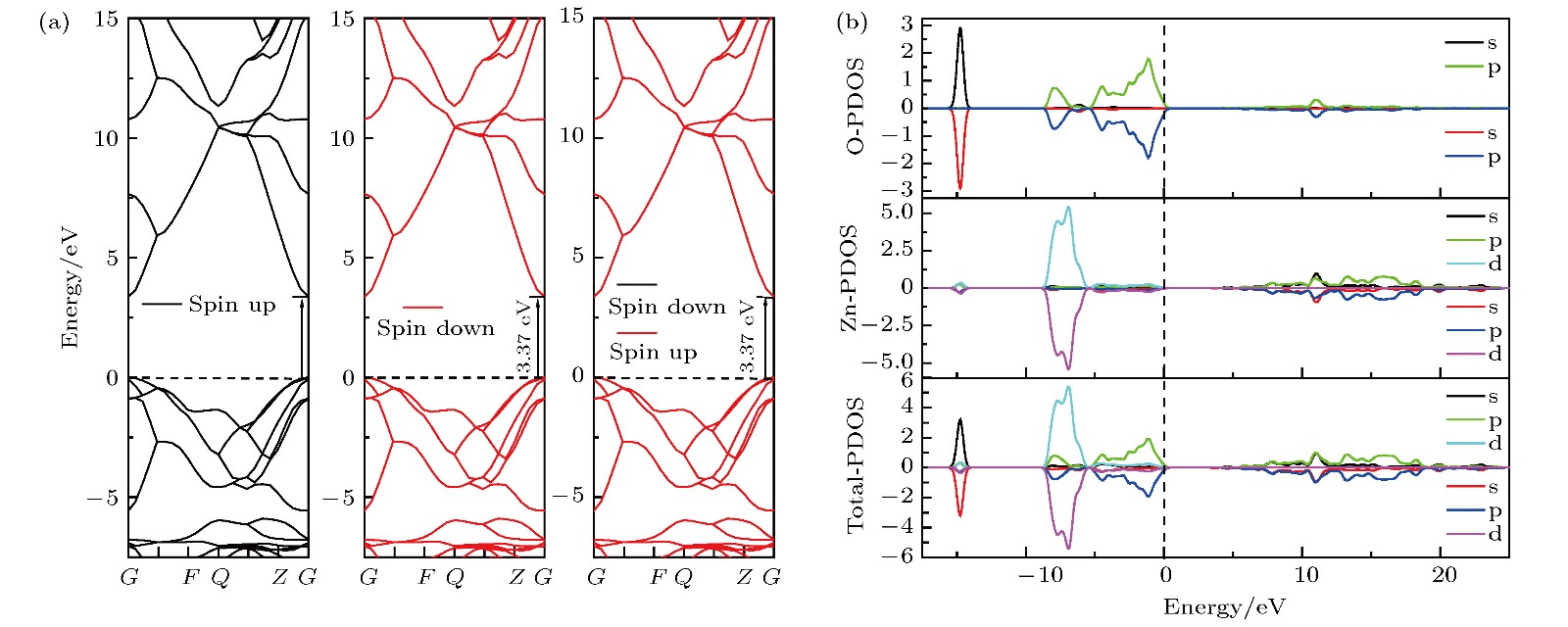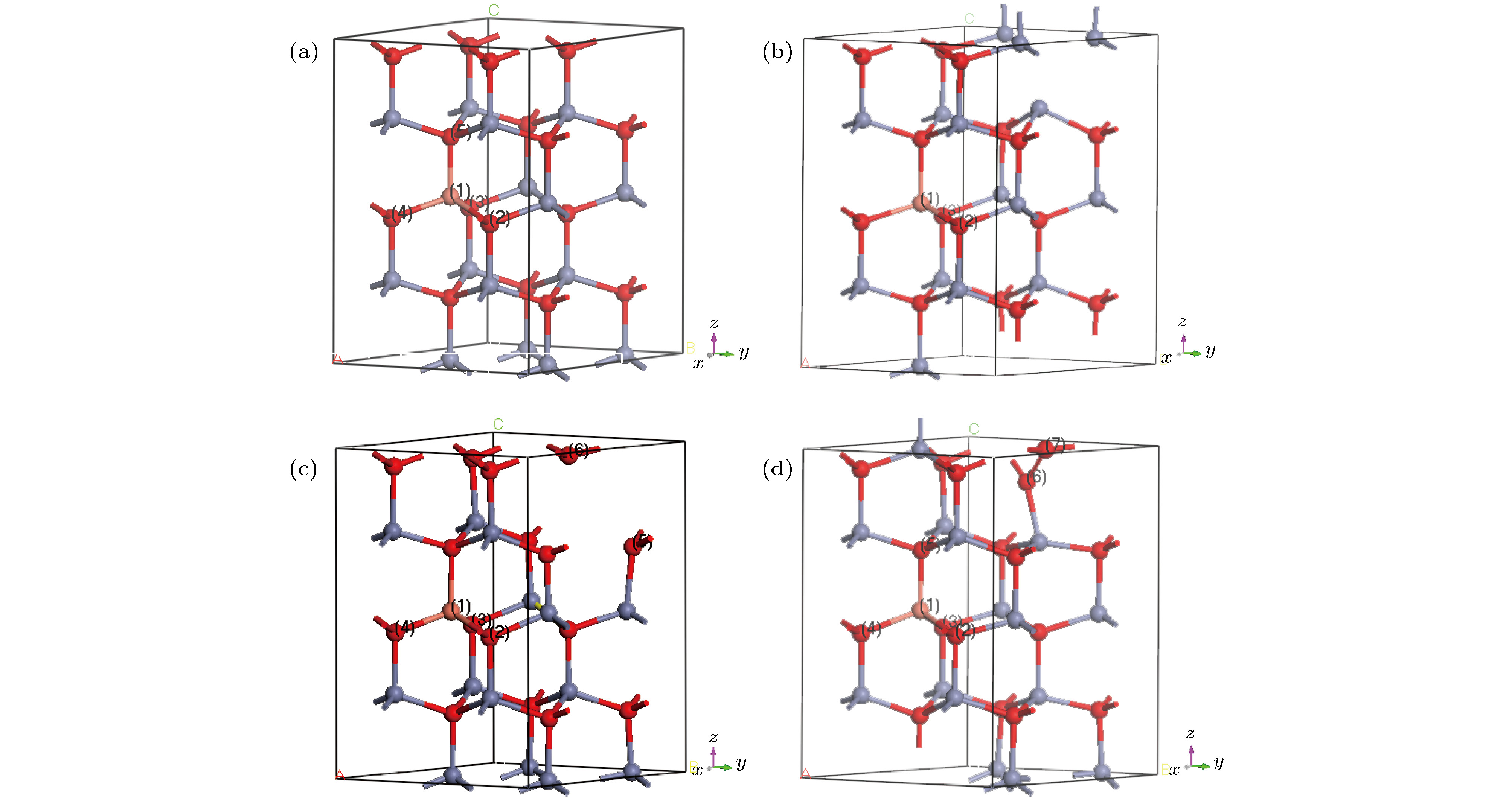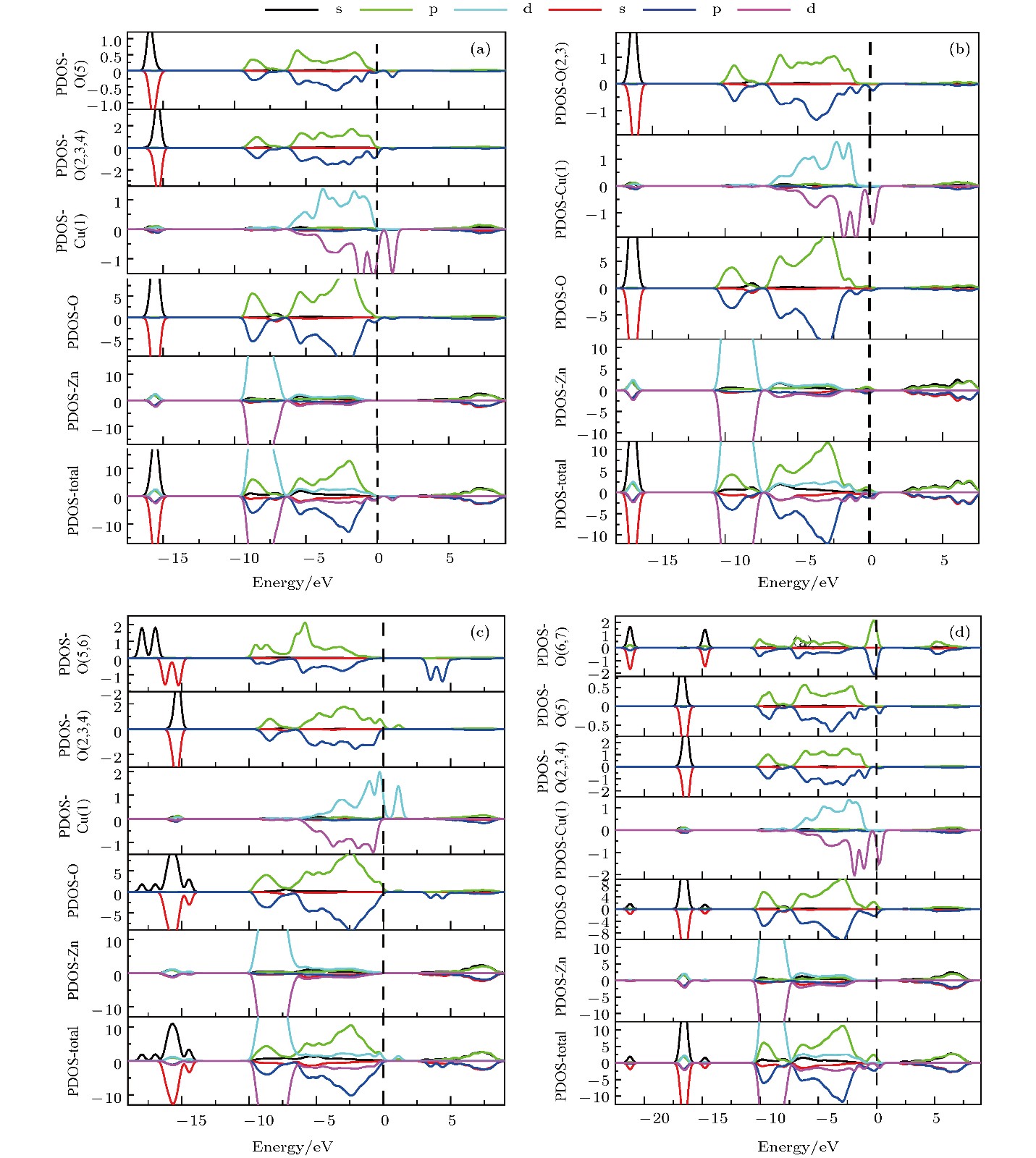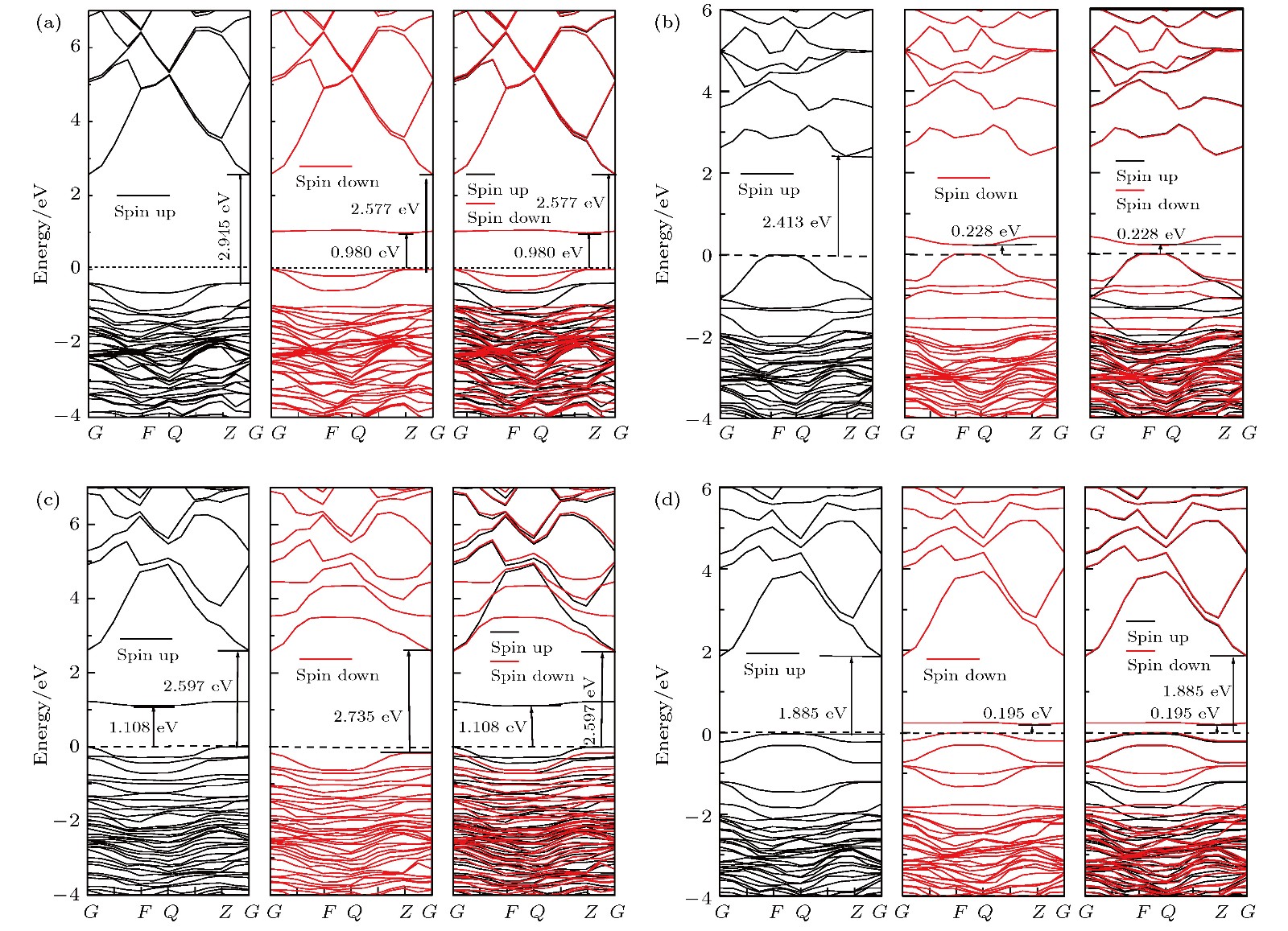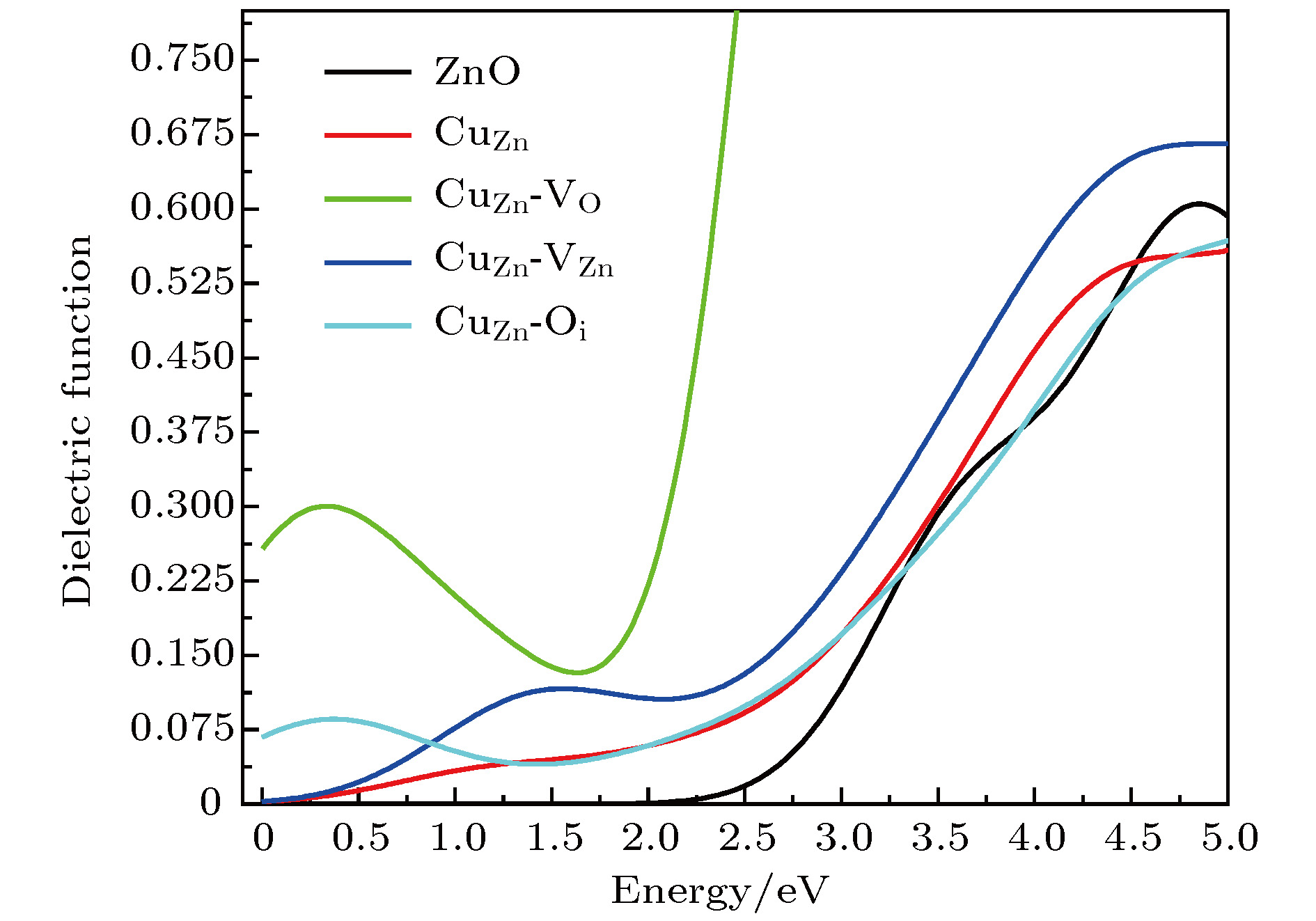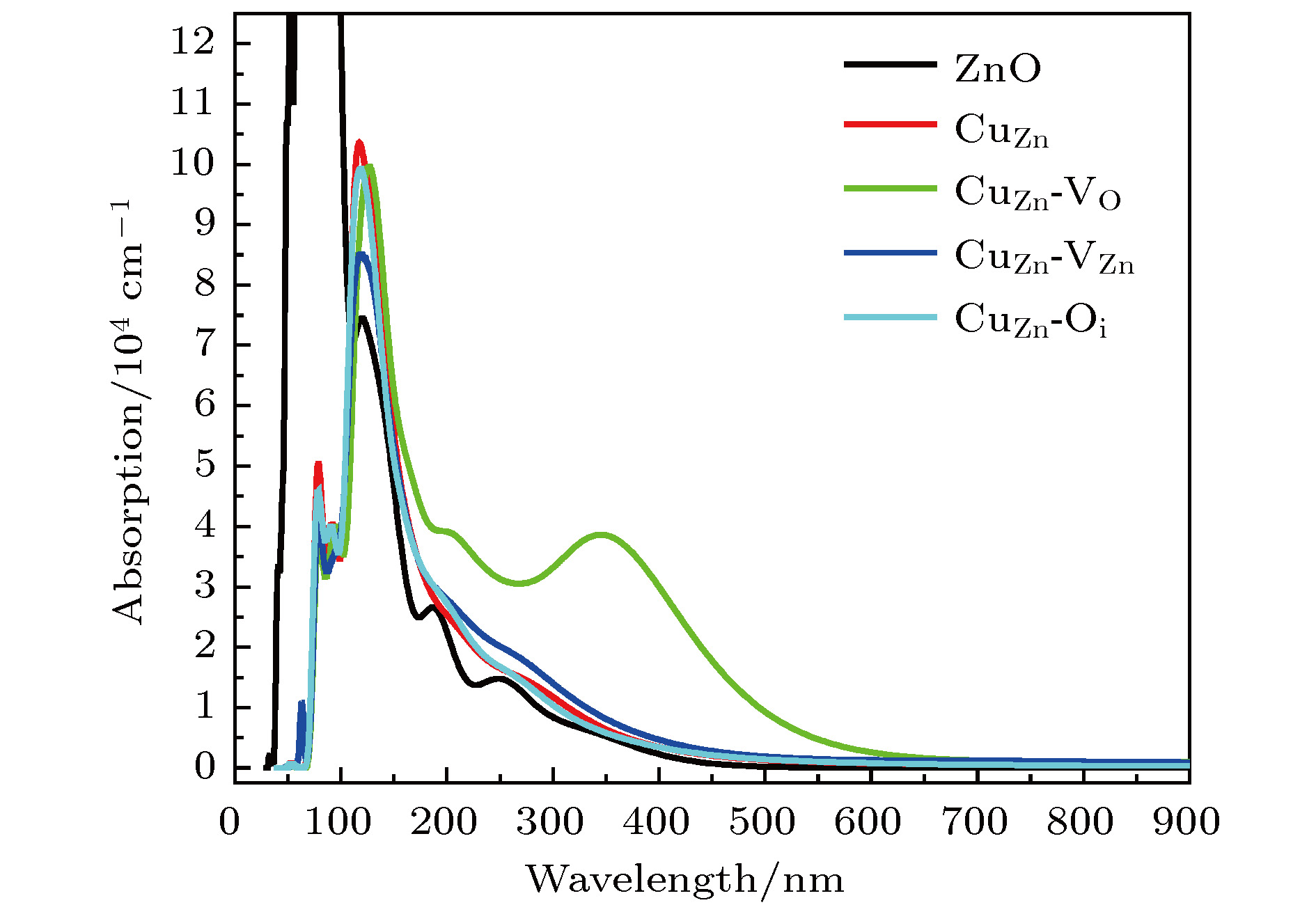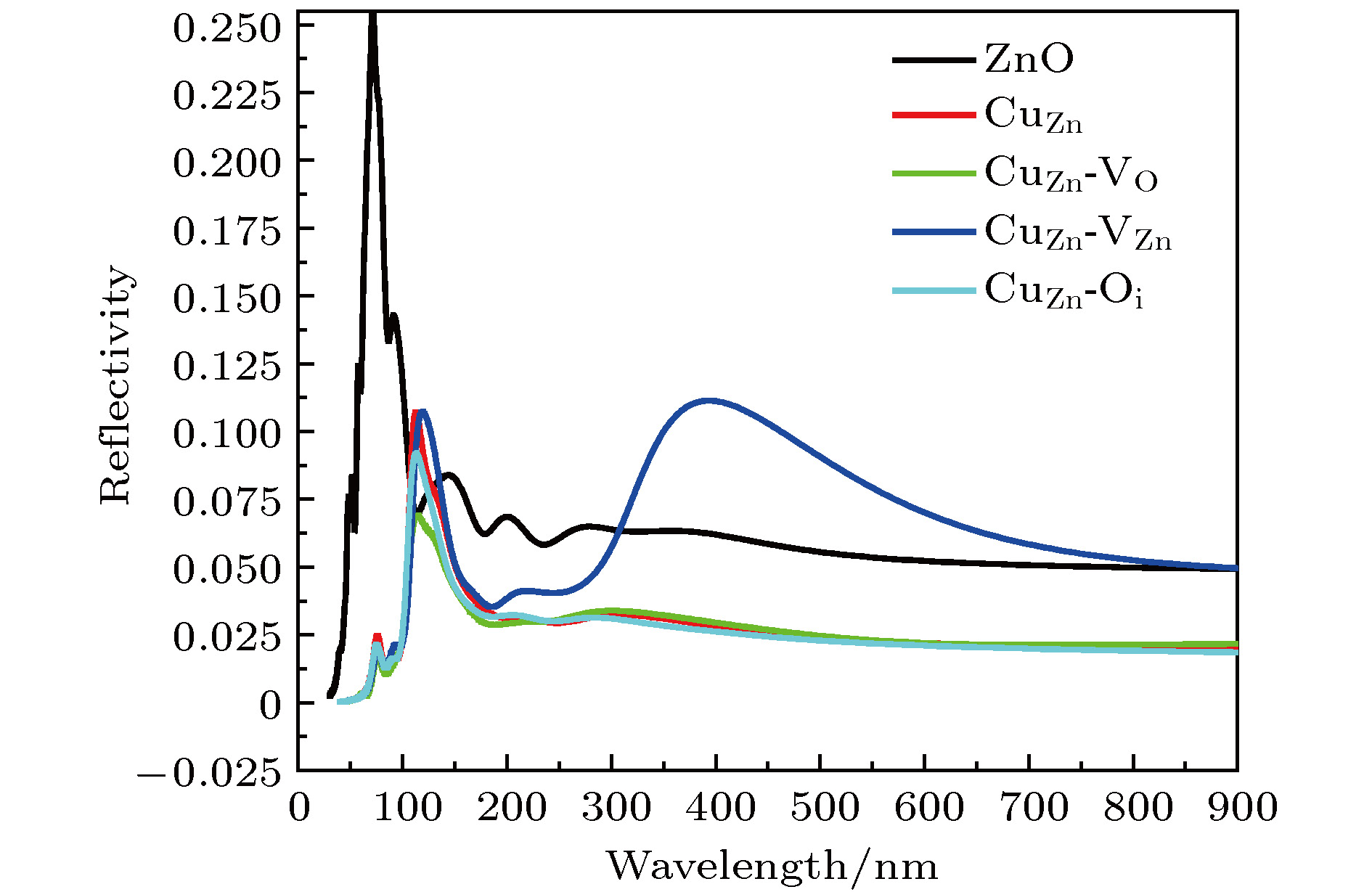-
采用基于自旋密度泛函理论的平面波超软赝势方法, 研究了Cu掺杂ZnO (简称CuZn)与内在缺陷共存对ZnO电磁光性质的影响. 结果表明, Cu是以替位受主的形式掺入的; 制备条件对CuZn及内在缺陷的形成起至关重要的作用, 富氧条件下Cu掺杂有利于内在缺陷的形成, 且CuZn-Oi最易形成; 相反在缺氧条件下, Cu掺杂不利于内在缺陷的形成. 替位Cu的3d电子在价带顶形成未占据受主能级, 产生p导电类型. 与CuZn体系相比, CuZn-VO体系中载流子浓度降低, 导电性变差; CuZn-VZn体系中载流子浓度几乎不变, 对导电性没影响; CuZn-Oi体系中载流子浓度升高, 导电性增强. 纯ZnO体系无磁性; 而Cu掺杂ZnO体系, 与Cu原子相连的O原子, 电负性越小, 键长越短, 对磁矩贡献越大; CuZn与CuZn-Oi体系中的磁矩主要是Cu的3d电子与Z轴上O的2p电子耦合产生的; CuZn中存在空位缺陷(VO, VZn)时, 磁矩主要是Cu 3d电子与XY平面内O的2p电子强烈耦合所致; CuZn中存在VZn时, 磁性还包含VZn周围O(5, 6)号原子2p轨道自旋极化的贡献; 所有体系中Zn原子自旋对称, 不产生磁性. CuZn-VZn和CuZn-Oi缺陷能态中, 深能级中产生的诱导态是O-O 2s电子相互作用产生的. CuZn模型的光学带隙减小, 导致吸收边红移; CuZn-VZn模型中吸收和反射都增强, 使得透射率降低.For ZnO which is not magnetic itself, it is of great significance to study the source of ferromagnetism and its photoelectric properties when Cu doped ZnO coexists with internal defects. The effects of intrinsic defects on the electronic structures, magnetic and optical properties of Cu-doped ZnO (CuZn) are studied by using first principle calculations based on the density functional theory combined with the Hubbard U (DFT + Ud + Up). The results indicate that the doped Cu is a substitute acceptor, and the manufacturing environment plays an important role in forming the CuZn with internal defects. Under the oxygen-rich condition, the doped Cu is favorable for forming internal defects, and the CuZn—Oi bonds are easily formed. On the contrary, the Cu-doped ZnO is not conducive to forming internal defects under the O-poor condition. The 3d electrons of the substitute Cu form the unoccupied accepter energy level at the top of valence band, generating p-type conduction. Comparing with CuZn system, the carrier concentration of positive hole decreases in CuZn-VO system and the conductivity is poor. In the CuZn-VZn system, the number of carrier holes is almost constant, and the conductivity has no effect. In the CuZn-Oi model, the carrier concentration of positive holes increases and the conductivity gets better. The pure ZnO system exhibits non-magnetic behavior. The study also reveals that the smaller the electro-negativity, the greater the contribution to magnetic moment is when O atom is connected with Cu atom. The magnetic moments in CuZn and CuZn-Oi system are mainly generated by the coupling between the Cu 3d and the O 2p orbital on the c axis. When VO and VZn exist in CuZn, the magnetic moment is mainly caused by the strong coupling of Cu 3d with O 2p in ab plane. In the presence of VZn in CuZn, the magnetism also contains the contribution of the spin polarization of O(5, 6) atoms around VZn. In the defect states of CuZn-VZn and CuZn-Oi, the induced states in the deep energy levels are generated by the interaction between the O-O 2s orbital electrons. The reduced optical band gap of the CuZn model results in the red shift of absorption spectrum. The enhanced absorption and reflection of the CuZn-VZn model reduce the transmission.
-
Keywords:
- first principles /
- intrinsic defect /
- Cu-doped ZnO /
- formation energy
[1] Wang Z L 2008 ACS Nano 2 1987
 Google Scholar
Google Scholar
[2] Ahn K S, Deutsch T, Yan Y, Jiang C S, Perkins C L, Turner J, Jassim M A 2007 J. Appl. Phys. 102 023517
 Google Scholar
Google Scholar
[3] Wei M, Braddon N, Zhi D, Midgley P A, Chen S K, Blamire M G, Driscoll J L M 2005 Appl. Phys. Lett. 86 072514
 Google Scholar
Google Scholar
[4] Drmosh Q A, Rao S G, Yamani Z H, Gondal M A 2013 Appl. Surf. Sci. 270 104
 Google Scholar
Google Scholar
[5] Suja M, Bashar S B, Morshed M M, Liu J 2015 ACS Appl. Mater. Interfaces 7 8894
 Google Scholar
Google Scholar
[6] Chakraborty M, Ghosh A, Thangavel R 2015 J. Sol-Gel Sci. Technol. 74 756
 Google Scholar
Google Scholar
[7] Horzum S, Torun E, Serin T, Peeters F M 2016 Philos. Mag. 96 1743
 Google Scholar
Google Scholar
[8] Vachhani P S, Bhatnagar A K 2013 Phys. Scr. 8715 045702
[9] Xia C H, Wang F, Hu C L 2014 J. Alloys Compd. 589 604
 Google Scholar
Google Scholar
[10] 侯清玉, 许镇潮, 乌云, 赵二俊 2015 物理学报 64 167201
 Google Scholar
Google Scholar
Hou Q Y, Xu Z C, Wu Y, Zhao E J 2015 Acta Phys. Sin. 64 167201
 Google Scholar
Google Scholar
[11] Iqbal J, Jan T, Shafiq M, Arshad A, Ahmad N, Badshah S, Yu R H 2014 Ceram. Int. 40 2091
 Google Scholar
Google Scholar
[12] Li T J, Li G P, Gao X X, Chen J S 2010 Chin. Phys. Lett. 27 211
[13] Nia B A, Shahrokhi M, Moradian R, Manouchehri I 2014 Eur. Phys. J. Appl. Phys. 67 20403
 Google Scholar
Google Scholar
[14] Keavney D J, Buchholz D B, Ma Q, Chang R P 2007 Appl. Phys. Lett. 91 012501
 Google Scholar
Google Scholar
[15] Xu Q Y, Schmidt H, Zhou S Q, Potzger K, Helm M, Hochmuth H, Lorenz M, Setzer A, Esquinazi P, Meinecke C, Grundmann M 2008 Appl. Phys. Lett. 92 082508
 Google Scholar
Google Scholar
[16] Zhu M Y, Zhang Z H, Zhong M, Tariq M, Li Y, Li W X, Jin H M, Skotnicova K, Li Y B 2017 Ceram. Int. 43 3166
 Google Scholar
Google Scholar
[17] Luo J H, Liu Q, Yang L N, Sun Z Z, Li Z S 2014 Comput. Mater. Sci. 82 70
 Google Scholar
Google Scholar
[18] Wang Q B, Zhou C, Wu J, Lü T 2013 Opt. Commun. 297 79
 Google Scholar
Google Scholar
[19] Chen Y F, Song Q G, Yan H Y 2012 Comput. Theor. Chem. 983 65
 Google Scholar
Google Scholar
[20] Lee M H, Peng Y C, Wu H C 2014 J. Alloys Compd. 616 122
 Google Scholar
Google Scholar
[21] Wu H C, Peng Y C, Chen C C 2013 Opt. Mater. 35 509
 Google Scholar
Google Scholar
[22] Segall M D, Lindan P J D, Probert M J, Pickard C J, Hasnip P J, Clark S J, Payne M C 2002 J. Phys.: Condens. Matter 14 2717
 Google Scholar
Google Scholar
[23] Perdew J P, Burke K, Ernzerhof M 1996 Phys. Rev. Lett. 77 3865
 Google Scholar
Google Scholar
[24] Ma X G, Lu B, Li D, Shi R, Pan C S, Zhu Y F 2011 J. Phys. Chem. C 115 4680
[25] Anisimov V V, Zaanen J, Andersen K 1991 Phys. Rev. B: Condens. Matter 44 943
 Google Scholar
Google Scholar
[26] Monkhost H J, Pack J D 1976 Phys. Rev. B 13 5188
 Google Scholar
Google Scholar
[27] Vanderbilt D 1990 Phys. Rev. B: Condens. Matter 41 7892
 Google Scholar
Google Scholar
[28] Janotti A, van de Walle C G 2007 Phys. Rev. B 76 165202
 Google Scholar
Google Scholar
[29] Guo T T, Dong G B, Chen Q, Diao X G, Gao F Y 2014 J. Phys. Chem. Solids 75 42
 Google Scholar
Google Scholar
[30] Sun H G, Fan W L, Li Y L, Cheng X F, Li P, Hao J C, Zhao X 2011 Phys. Chem. Chem. Phys. 13 1379
 Google Scholar
Google Scholar
[31] Chen Y, Xu X L, Zhang G H, Xue H, Ma S Y 2009 Physica B 404 3645
 Google Scholar
Google Scholar
[32] 段壮芬, 王新强, 何阿玲, 程志梅 2011 原子与分子物理学报 28 343
 Google Scholar
Google Scholar
Duan Z F, Wang X Q, He A L, Cheng Z M 2011 J. At. Mol. Phys. 28 343
 Google Scholar
Google Scholar
[33] Ferhat M, Zaoui A, Ahuja R 2009 Appl. Phys. Lett. 94 142502
 Google Scholar
Google Scholar
[34] Yan Y F, Aljassim M M, Wei S H 2006 Appl. Phys. Lett. 89 181912
 Google Scholar
Google Scholar
[35] Narendra G L, Sreedhar B, Rao J L, Lakshman S V J 1991 J. Mater. Sci. 26 5342
 Google Scholar
Google Scholar
[36] Lee H Y, Clark S J, Robertson J 2012 Phys. Rev. B 86 075209
 Google Scholar
Google Scholar
[37] 林俏露, 李公平, 许楠楠, 刘欢, 王苍龙 2017 物理学报 66 037101
 Google Scholar
Google Scholar
Lin Q L, Li G P, Xu N N, Liu H, Wang C L 2017 Acta Phys. Sin. 66 037101
 Google Scholar
Google Scholar
[38] Zhao L, Lu P F, Yu Z Y, Liu Y M, Wang D L, Ye H 2010 Chin. Phys. B 19 056104
 Google Scholar
Google Scholar
[39] 徐庆岩, 吴雪梅, 诸葛兰剑, 陈学梅, 吴兆丰 2008 微细加工技术 12 16
Xu Q Y, Wu X M, Zhuge L J, Chen X M, Wu Z F 2008 MicroFabric. Tech. 12 16
-
表 1 ZnO和CuZn缺陷的形成能(单位: eV)
Table 1. Formation energy of ZnO and CuZn with intrinsic defects (in eV)
缺陷类型 VO VZn Oi Cui CuZn CuZn-VO CuZn-VZn CuZn-Oi O-rich 6.603 0.915 –0.548 5.795 –0.495 6.337 0.422 –0.965 O-poor 1.308 6.210 4.747 4.026 3.031 4.569 9.244 7.856 表 2 ZnO模型的带隙和空穴浓度P
Table 2. Band gap and hole concertration P of ZnO model
ZnO CuZn CuZn-VO CuZn-VZn CuZn-Oi 禁带宽度/eV 3.370 2.577 2.413 2.597 1.885 光学带隙/eV 3.370 0.980 0.228 1.108 0.195 P 0.068 1.344 1.107 1.321 1.574 -
[1] Wang Z L 2008 ACS Nano 2 1987
 Google Scholar
Google Scholar
[2] Ahn K S, Deutsch T, Yan Y, Jiang C S, Perkins C L, Turner J, Jassim M A 2007 J. Appl. Phys. 102 023517
 Google Scholar
Google Scholar
[3] Wei M, Braddon N, Zhi D, Midgley P A, Chen S K, Blamire M G, Driscoll J L M 2005 Appl. Phys. Lett. 86 072514
 Google Scholar
Google Scholar
[4] Drmosh Q A, Rao S G, Yamani Z H, Gondal M A 2013 Appl. Surf. Sci. 270 104
 Google Scholar
Google Scholar
[5] Suja M, Bashar S B, Morshed M M, Liu J 2015 ACS Appl. Mater. Interfaces 7 8894
 Google Scholar
Google Scholar
[6] Chakraborty M, Ghosh A, Thangavel R 2015 J. Sol-Gel Sci. Technol. 74 756
 Google Scholar
Google Scholar
[7] Horzum S, Torun E, Serin T, Peeters F M 2016 Philos. Mag. 96 1743
 Google Scholar
Google Scholar
[8] Vachhani P S, Bhatnagar A K 2013 Phys. Scr. 8715 045702
[9] Xia C H, Wang F, Hu C L 2014 J. Alloys Compd. 589 604
 Google Scholar
Google Scholar
[10] 侯清玉, 许镇潮, 乌云, 赵二俊 2015 物理学报 64 167201
 Google Scholar
Google Scholar
Hou Q Y, Xu Z C, Wu Y, Zhao E J 2015 Acta Phys. Sin. 64 167201
 Google Scholar
Google Scholar
[11] Iqbal J, Jan T, Shafiq M, Arshad A, Ahmad N, Badshah S, Yu R H 2014 Ceram. Int. 40 2091
 Google Scholar
Google Scholar
[12] Li T J, Li G P, Gao X X, Chen J S 2010 Chin. Phys. Lett. 27 211
[13] Nia B A, Shahrokhi M, Moradian R, Manouchehri I 2014 Eur. Phys. J. Appl. Phys. 67 20403
 Google Scholar
Google Scholar
[14] Keavney D J, Buchholz D B, Ma Q, Chang R P 2007 Appl. Phys. Lett. 91 012501
 Google Scholar
Google Scholar
[15] Xu Q Y, Schmidt H, Zhou S Q, Potzger K, Helm M, Hochmuth H, Lorenz M, Setzer A, Esquinazi P, Meinecke C, Grundmann M 2008 Appl. Phys. Lett. 92 082508
 Google Scholar
Google Scholar
[16] Zhu M Y, Zhang Z H, Zhong M, Tariq M, Li Y, Li W X, Jin H M, Skotnicova K, Li Y B 2017 Ceram. Int. 43 3166
 Google Scholar
Google Scholar
[17] Luo J H, Liu Q, Yang L N, Sun Z Z, Li Z S 2014 Comput. Mater. Sci. 82 70
 Google Scholar
Google Scholar
[18] Wang Q B, Zhou C, Wu J, Lü T 2013 Opt. Commun. 297 79
 Google Scholar
Google Scholar
[19] Chen Y F, Song Q G, Yan H Y 2012 Comput. Theor. Chem. 983 65
 Google Scholar
Google Scholar
[20] Lee M H, Peng Y C, Wu H C 2014 J. Alloys Compd. 616 122
 Google Scholar
Google Scholar
[21] Wu H C, Peng Y C, Chen C C 2013 Opt. Mater. 35 509
 Google Scholar
Google Scholar
[22] Segall M D, Lindan P J D, Probert M J, Pickard C J, Hasnip P J, Clark S J, Payne M C 2002 J. Phys.: Condens. Matter 14 2717
 Google Scholar
Google Scholar
[23] Perdew J P, Burke K, Ernzerhof M 1996 Phys. Rev. Lett. 77 3865
 Google Scholar
Google Scholar
[24] Ma X G, Lu B, Li D, Shi R, Pan C S, Zhu Y F 2011 J. Phys. Chem. C 115 4680
[25] Anisimov V V, Zaanen J, Andersen K 1991 Phys. Rev. B: Condens. Matter 44 943
 Google Scholar
Google Scholar
[26] Monkhost H J, Pack J D 1976 Phys. Rev. B 13 5188
 Google Scholar
Google Scholar
[27] Vanderbilt D 1990 Phys. Rev. B: Condens. Matter 41 7892
 Google Scholar
Google Scholar
[28] Janotti A, van de Walle C G 2007 Phys. Rev. B 76 165202
 Google Scholar
Google Scholar
[29] Guo T T, Dong G B, Chen Q, Diao X G, Gao F Y 2014 J. Phys. Chem. Solids 75 42
 Google Scholar
Google Scholar
[30] Sun H G, Fan W L, Li Y L, Cheng X F, Li P, Hao J C, Zhao X 2011 Phys. Chem. Chem. Phys. 13 1379
 Google Scholar
Google Scholar
[31] Chen Y, Xu X L, Zhang G H, Xue H, Ma S Y 2009 Physica B 404 3645
 Google Scholar
Google Scholar
[32] 段壮芬, 王新强, 何阿玲, 程志梅 2011 原子与分子物理学报 28 343
 Google Scholar
Google Scholar
Duan Z F, Wang X Q, He A L, Cheng Z M 2011 J. At. Mol. Phys. 28 343
 Google Scholar
Google Scholar
[33] Ferhat M, Zaoui A, Ahuja R 2009 Appl. Phys. Lett. 94 142502
 Google Scholar
Google Scholar
[34] Yan Y F, Aljassim M M, Wei S H 2006 Appl. Phys. Lett. 89 181912
 Google Scholar
Google Scholar
[35] Narendra G L, Sreedhar B, Rao J L, Lakshman S V J 1991 J. Mater. Sci. 26 5342
 Google Scholar
Google Scholar
[36] Lee H Y, Clark S J, Robertson J 2012 Phys. Rev. B 86 075209
 Google Scholar
Google Scholar
[37] 林俏露, 李公平, 许楠楠, 刘欢, 王苍龙 2017 物理学报 66 037101
 Google Scholar
Google Scholar
Lin Q L, Li G P, Xu N N, Liu H, Wang C L 2017 Acta Phys. Sin. 66 037101
 Google Scholar
Google Scholar
[38] Zhao L, Lu P F, Yu Z Y, Liu Y M, Wang D L, Ye H 2010 Chin. Phys. B 19 056104
 Google Scholar
Google Scholar
[39] 徐庆岩, 吴雪梅, 诸葛兰剑, 陈学梅, 吴兆丰 2008 微细加工技术 12 16
Xu Q Y, Wu X M, Zhuge L J, Chen X M, Wu Z F 2008 MicroFabric. Tech. 12 16
计量
- 文章访问数: 17116
- PDF下载量: 171
- 被引次数: 0













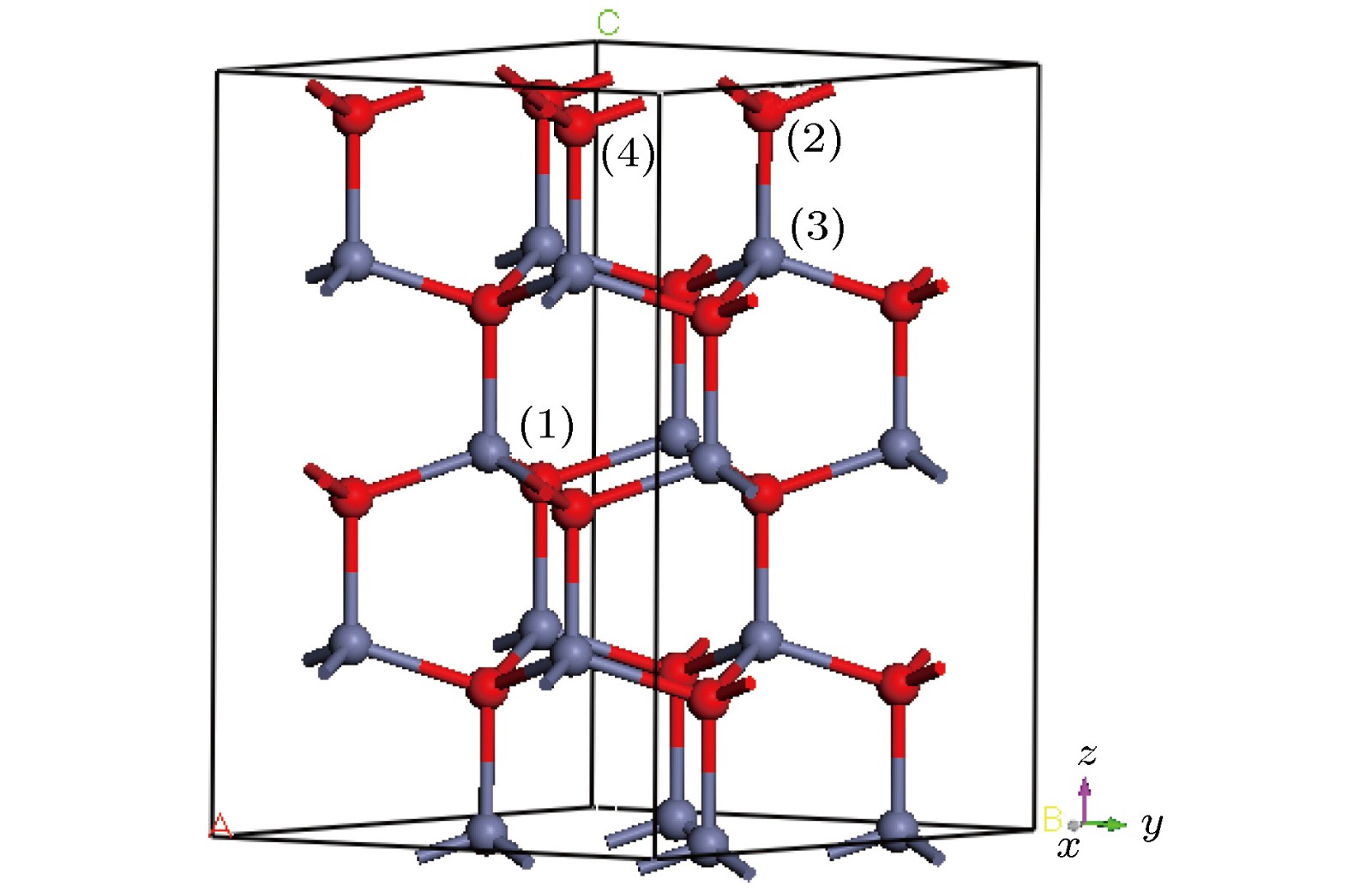
 下载:
下载:
